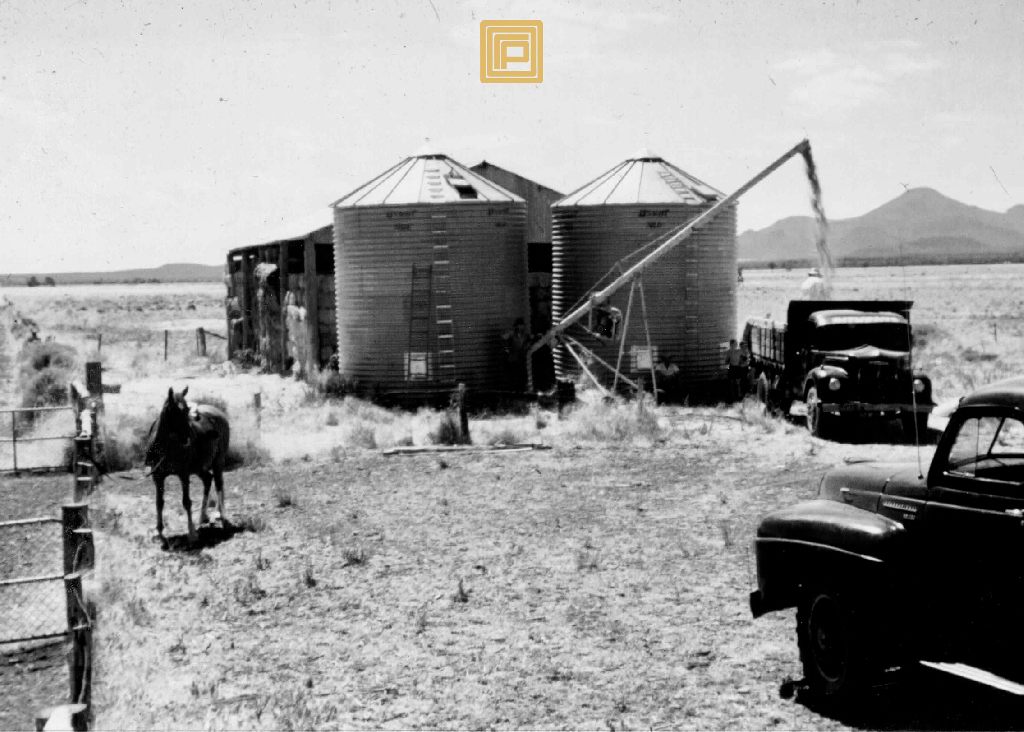Calatoota and the Campbell Family
Calatoota was originally part of the sprawling Edgeroi Station which was resumed for soldier settlement after WWII. The history of the property since being drawn by Peter Campbell in the 1947 ballot reflects the evolution of the famous farming district.

Block 20, part of the Edgeroi Station Soldier Settlement Scheme, was drawn by Peter Campbell in a ballot on 29th December 1947.
Peter, a navy signalman on HMAS Cessnock during World War 2 & a new graduate of Hawkesbury Agricultural College, was on his honeymoon in the Blue Mountains when he received the news. He named it Calatoota.
When Peter & Eris arrived at Calatoota in early 1948, infrastructure consisted of a stock water bore and some front boundary fencing. The neighbours on Old Edgeroi kindly allowed the newlyweds to live in their slab cottage until a home could be constructed. Sadly, Eris didn’t get to see the home built as she became ill with leukaemia & died before the end of 1948.
Fencing began immediately and like most in the district, Calatoota was a producer of Merino wool. Shearing was carried out in the Old Edgeroi shearing shed until the Calatoota shed was built in 1965. Additionally, there was a small herd of cattle that commenced with a cow given to Peter when he was 7 years old.
The house bore was drilled in 1950, & the first wheat crop was grown in conjunction with a share-farmer the same year.
In 1952 Peter married Judy Smith. A weatherboard garage was the first accommodation on Calatoota, followed by the house 1952/53. It was extended in 1959 as Jude’s well-planned family of 3 children became 4...... & then 5! Over the years the house was extensively renovated to become the comfortable home it is today.
The first farm machinery was purchased in 1952 & Peter began to crop Calatoota himself, along with share-farming that continued until approximately 1954.
From the 1950s through to the 1970s, the property was managed as a mixed farming enterprise; with wheat & lucerne being rotated & sheep intensively cell grazed on lucerne during the 1960s & 1970s. Sheep/wool production ceased in the early 1970s, although the beef herd continued and a cattle feedlot was established in the late 1960s.
In the early to mid 1970s, Peter’s sons Andrew, Duncan & Ross joined the family partnership (Calatoota Pastoral Co) as each finished secondary schooling.
In the mid 1970s strip farming was introduced & other crops such as sorghum & sunflowers were added to the rotation.
In 1981 the first dryland cotton crop was planted. Other crops trialled during the 1980s included safflower, soya beans, mung beans, chickpeas & cow peas.
In 1991 when Peter & Judy retired to Narrabri. Andrew, Tracey & their children Sandy, Julia, Sally & Annabel moved into the Calatoota homestead. Once again, the house was filled with children & a ready source of cheap labour around the farm.
A rotation of wheat & cotton became the standard rotation until 2006. Long fallow cotton, double cropped to wheat (as a cover crop) was a very effective rotation until Roundup Ready Bollgard cotton was introduced.
Since 2007; wheat, sorghum & chickpeas have been the usual cropping rotation. Cotton has only been grown as an opportunity crop; depending on moisture, price & enthusiasm. It was last grown in 2017.
After 73 years in the Campbell family, Calatoota is going to auction on the 2nd December 2021. Tracey and Andrew are moving closer to the coast to spend more time with their family. With the impending sale, a new chapter in the future of the property is about to begin.
To view photos of the property as it is today, visit Calatoota Listing.
by Michael Guest in Latest News
Share this post
Posts this year
- October 2024 (1)
- September 2024 (1)
- August 2024 (1)
- November 2023 (1)
- June 2023 (1)
- February 2023 (2)
- November 2022 (1)
- October 2022 (1)
- July 2022 (2)
- June 2022 (1)
Archived Posts
- Posts in 2023
- Posts in 2022
- Posts in 2021
- Posts in 2020
- Posts in 2019
- Posts in 2018
- Posts in 2017
- Posts in 2016
